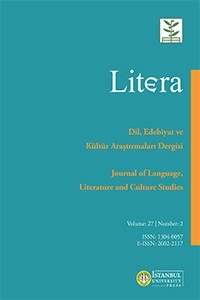Oriented Speech in Maalouf’s The Disoriented (Les Désorientés)
The ultimate goal of literary discourse is not necessarily for readers to simply accept what the story tells. Literary discourse tries to convey a message to the reader by telling a story. Ruth Amossy distinguishes among two types of argument discourses: argumentative dimension and argumentative aiming discourses. Using Amossy’s interpretation, this paper will attempt to answer the question: “Are there some literary discourses in general and novels in particular that have more argumentative goals than others?” In our attempt to answer this question, our present work will be based on Amin Maalouf’s novel The Disoriented (Les Désorientés). This novel tells the story of Adam, who returns to his native country after 25 years of exile. Adam is also the narrator of the novel. It is the story of a group of friends, inseparable 25 years ago, but nowadays scattered to the four corners of the world after the civil war in Lebanon. To answer the first cited question, we will first analyze the enunciative, discursive, and narrative processes the narrator uses to stage his semi literary and at the same time argumentative speeches; then we will discuss the question of ethos or author posture the author gives to the reader through his novel.
Keywords:
argumentation, narration, enunciation, ethos, Discourse ethos,
___
- Adam, J. M. (2008). La linguistique textuelle. Paris, FR: Armand Colin.
- Amossy, R. (1999). Images de soi dans le discours. Paris, FR: Delachaux et Niestlé.
- Amossy, R. (2006). L’argumentation dans le discours. Paris, FR : Armand Colin.
- Amossy, R. (2009). La double nature de l’image d’auteur. Argumentation et Analyse du Discours, 3, 1–15
- Amossy, R. (2010). Présentation de soi. Ethos et identité verbale. Paris, FR: PUF.
- Bordas, E., & Molinié, G. ( 2015). De l’éthos au style. La présentation de soi sur les sites de rencontre. In E. Bordas & G. Molinié (Eds.), Style, langue et société (pp. 283–298). Paris, FR: Champion.
- Maalouf, A. (2007). Les identités meurtrières. Paris, FR: Collection Livre de Poche.
- Maalouf, A. (2012). Les Désorientés. Paris, FR: Grasset.
- Maingeuneau, D. (1999). Ethos, scénographie, incorporation dans Amossy. Paris, FR: Delachaux et Niestlé.
- Maingueneau, D. (2004). Le discours littéraire. Paris, FR: Armand Colin.
- Maingueneau, D. (2009). Auteur et image d’auteur en analyse du discours. Argumentation et Analyse du Discours, 3, 1–15.
- Maingueneau, D. (2014). Le recours à l’ethos dans l’analyse du discours littéraire. Fabula, 113, 1–18.
- Meizoz, J. (2009). Ce que l’on fait dire au silence : Posture, ethos, image d’auteur . Argumentation et Analyse du Discours, 3, 1–11.
- Başlangıç: 1954
- Yayıncı: İstanbul Üniversitesi
